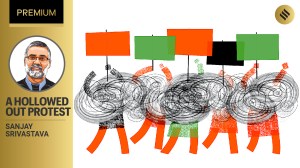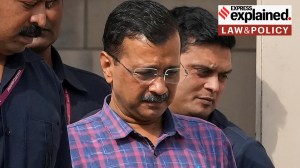- India
- International
Electoral Bonds and Electoral Trusts: What are they, and how do they differ?
Electoral Bonds, now under challenge before the Supreme Court, have become the primary route of political funding since they were launched in 2018. The key difference between the Trusts and Bonds is in the degrees of transparency they offer, and the Bonds Scheme's focus on the anonymity of donors
 A new window for the sale of EBs opened on November 6. (Photo: Pixabay/Representational)
A new window for the sale of EBs opened on November 6. (Photo: Pixabay/Representational) After a three-day hearing, the Supreme Court on November 3 reserved its judgment on the challenge to the central government’s Electoral Bonds Scheme.
Before the controversial Electoral Bonds (EB) Scheme was introduced in 2018, there was something called an Electoral Trusts (ET) Scheme, which was introduced by the UPA government in 2013.
Both schemes were meant to facilitate donations to political parties by corporates and individuals. But while the EB scheme seeks to ensure anonymity for the donor, the electoral trusts under the previous scheme were required to submit to the Election Commission of India a report on contributions from individuals and companies, and their donations to parties every year.
This is how the two schemes have worked so far.
First, what are electoral trusts?
Under the scheme notified by the UPA-2 government on January 31, 2013, any company registered under Section 25 of the Companies Act, 1956, can form an electoral trust.

Under Section 17CA of the Income-tax Act, 1961, any citizen of India, a company registered in India, or a firm or Hindu Undivided Family or association of persons living in India, can donate to an electoral trust.
| ELECTORAL TRUSTS YEARLY DONATION (2013-14 to 2021-22) | |
| Year | Donation (in Rs cr) |
| 2013-14 | 85.37 |
| 2014-15 | 177.4 |
| 2015-16 | 49.50 |
| 2016-17 | 325.27 |
| 2017-18 | 194.78 |
| 2018-19 | 266.14 |
| 2019-20 | 424.66 |
| 2020-21 | 258.43 |
| 2021-22 | 487.05 |
| Total | 2,268.6 |
| Source: Annual contribution reports of ETs to ECI (2013-2014 till 2021-2022) |
|
The electoral trusts have to apply for renewal every three financial years. They must donate 95% of contributions received in a financial year to political parties registered under the Representation of the People Act, 1951. The contributors’ PAN (in case of a resident) or passport number (in case of an NRI) is required at the time of making contributions.
The number of registered trusts has ranged from three in 2013 to 17 in 2021-22, but only a few of them actually make donations every financial year.
And how does the working of this scheme differ from that of the EB Scheme?
The electoral trusts route is transparent on contributors and beneficiaries. Where there is only one contributor and one beneficiary of a particular trust, the public can know for sure who is funding whom. For instance, in 2018-19, the Janhit Electoral Trust had just one contribution of Rs.2.5 crore from Vedanta, and the entire amount was donated to the BJP, as per the trust’s annual contribution report.
However, if there are multiple contributors and recipients of donations, it cannot be specified which company is funding which party. So, Prudent Electoral Trust, which was known as Satya Electoral Trust before 2017, received contributions from a host of companies such as DLF, GMR, and Bharti Airtel, as well as several individuals, and donated to a range of national and regional parties. But it is difficult to pinpoint which donor gave to which party.
In fact, Prudent is the only trust that has given every year since the scheme started, with total donations adding up to more than Rs 1,891 crore from 2013-2014 to 2021-2022, which is the latest financial year for which reports are available. About 75% of total donations (Rs 1,430 crore) went to the BJP, and about 8.4% (Rs 160 crore) went to the Congress.
Electoral bonds, on the other hand, are exempt from disclosure requirements. Parties inform the ECI of the aggregate donations received through EBs, but give no details of the donors, which they are required to do in case of donations in cash or by cheque or bank transactions over Rs.20,000 each.
The government argues that this lack of transparency in donations through EBs is to maintain the privacy of donors.
How do donations through electoral trusts stack up against donations made through EBs?
Data from nine financial years (2013-14 to 2021-22) show that political funding through the two government schemes shot up after the introduction of EBs, with the bulk of donations coming through the newer scheme.
Over this entire nine-year period, a total Rs 2,269 crore was routed to parties though the ETs, from Rs 85.37 crore in 2013-14 to Rs 464.81 crore in 2021-22.
During the period 2017-18 — the financial year in which EBs were first made available — to 2021-22, however, the money donated through EBs was more than five times the amount that came through the Electoral Trusts. Thus, between 2017-18 and 2021-22, political parties got a total Rs 1,631 crore through ETs, while Rs 9,208 crore was donated through EBs.
In the six and a half years from the opening of the first sale window in March 2018 to the 10-day window that closed on October 13 this year, electoral bonds worth more than Rs 14,000 crore were sold by the State Bank of India, the only bank authorised to sell them, replies by the bank to questions asked under the Right to Information (RTI) Act, 2005, show.
A new window for the sale of EBs opened on November 6.
Which parties have received how much from electoral trusts?
The BJP got 72% of the total Rs 2,269 crore donated through electoral trusts from 2013-14 to 2021-22. This was higher than the share of the funding the BJP has got through electoral bonds (57%). However, the total EB corpus being much bigger than total ET donations, the actual amount the BJP got is much more than what it got through ETs.
The Congress got 10% of the total EB funding from March 2018 to October 2023, and 9.7% of the ET donations from 2013-14 to 2021-22.
The Trinamool Congress was the third biggest recipient of EBs (8.3%), though it got only 0.11% of ET funds. The Biju Janata Dal (BJD) was the third biggest beneficiary of donations through ETs after the BJP and Congress, and got about 1% of the total funds given by the trusts.
A report by the Association for Democratic Reforms (ADR) earlier this year found that more than 55% of the funding for political parties came through electoral bonds. In fact, for some parties, these bonds have become the only source of contributions — the BJD declared to the ECI that its entire income from “grants, donations and contributions” in 2021-22 came from EBs.
More Explained
Must Read
EXPRESS OPINION
May 11: Latest News
- 01
- 02
- 03
- 04
- 05









































